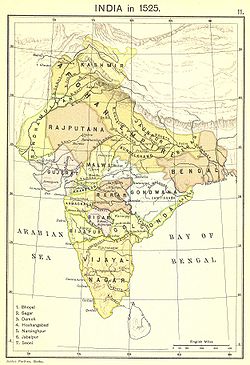
Back Kəşmir sultanlığı Azerbaijani Kashmirin sulttaanikunta Finnish カシュミール・スルターン朝 Japanese 카슈미르 술탄국 Korean کشمیر سلطنت Kashmiri Kašmiras sultanāts Latvian/Lettish Кашмирский султанат Russian Кашмірський султанат Ukrainian سلطنت کشمیر Urdu Kashmir sultonligi Uzbek
Sultanate of Kashmir | |||||||||||
|---|---|---|---|---|---|---|---|---|---|---|---|
| 1320–1323 1339–1589 | |||||||||||
| Motto: نرجو أن يتم الحفاظ عليها من الدمار (Arabic) (lit. May she be preserved from destruction)[3] | |||||||||||
 Kashmir Sultanate in 1525. (Including the hill states of Gilgit and Jammu, Maqpon Kingdom and Maryul Kingdom as tributary states) | |||||||||||
| Status | Sultanate | ||||||||||
| Capital | Srinagar (1320–1323; 1339–1343; 1354–1470; 1472–1529; 1530–1586) Sikandarpur (1470–1472) Naushahra (1529–1530) Chandrakot (1586–1587) Varmul (1587–1588) Suyyapur (1586–1588) no centralised capital (1588–1589) | ||||||||||
| Largest city | Srinagar | ||||||||||
| Common languages | Sanskrit (widely used in administration, court and government until the end of 14th century) Persian (widely used in administration, court and government) Kashmiri (native language, given official status later on) Dardic languages Arabic (religious) | ||||||||||
| Religion | State religion: Sunni Islam (Shafi'i and Hanafi) (1320–1561) Shi'a Islam (Imamiyya) (1561–1589) Minority religions: Hinduism Buddhism | ||||||||||
| Demonym(s) | Kashmiri | ||||||||||
| Government | Unitary centralized absolute monarchy | ||||||||||
| Sultan | |||||||||||
• 1320–1323 (first) | Sadr'ud-Din Shah | ||||||||||
• 1586–1589 (last) | Yakub Shah Chak | ||||||||||
| Wazir | |||||||||||
• 1320–1323 (first) | Tukka | ||||||||||
• 1586–1589 (last) | Nazuk Bhat | ||||||||||
| Legislature | Durbar | ||||||||||
• House | Divan | ||||||||||
| Historical era | Middle Ages | ||||||||||
• Conversion of Rinchan Shah | December 1320 | ||||||||||
• Lohara Interruption | 1323–1339 | ||||||||||
| 1338–1339 | |||||||||||
| December 1419–July 1420 | |||||||||||
| 1527–1531 | |||||||||||
• Kashgar–Kashmir War | January–May 1533 | ||||||||||
| 22 November 1540–October 1551 | |||||||||||
• Battle of Vahator | 13 August 1541 | ||||||||||
• Restoration | October 1551 | ||||||||||
| 20 December 1585–8 August 1589 | |||||||||||
| 10 October 1586 | |||||||||||
• Fall of Srinagar | 14 October 1586 | ||||||||||
| Area | |||||||||||
| 1342 | 222,236 km2 (85,806 sq mi) | ||||||||||
| 1389 | 250,000 km2 (97,000 sq mi) | ||||||||||
| Population | |||||||||||
• 1578 | 280,000 | ||||||||||
| Currency | Gold Dinar, Silver Sasnu, Copper Punchshi, Bronze Kasera | ||||||||||
| |||||||||||

The Kashmir Sultanate,[b] historically Latinised as the Sultanate of Cashmere and officially known as the State of Kashmir, was a medieval kingdom established in the early 14th century, primarily in the Kashmir Valley, found in the northern part of the Indian subcontinent. The Sultanate was founded by Rinchan Shah, a Ladakhi noble who converted from Buddhism to Islam. The Sultanate was briefly interrupted by the Loharas until Shah Mir, a councillor of Rinchan, overthrew the Loharas and started his own dynasty. The Shah Mirs ruled from 1339 until they were deposed by the Chak warlords and nobles in 1561. The Chaks continued to rule the Sultanate until the Mughal conquest in 1586 and their surrender in 1589.
The Kashmir Sultanate was a Muslim monarchy comprising Kashmiri, Turco–Persian, Kohistani, Dardic, & Ladakhi elites. A Ladakhi Buddhist, Rinchan Bhoti, converted to Islam and served as the first Sultan. He was followed by two prominent dynasties: The Shah Mirs and the Chaks. A Baihaqi Sayyid, Mubarak Baihaqi, briefly ruled over Sultanate after overthrowing Yousuf Chak in 1579. Due to its diversity, the kingdom lived and worked by the principles of Kashmiriyat, which existed harmoniously within the cultural and religious pluralism of the Sultanate. Although Sanskrit and Persian were preferred as the official, diplomatic, court, and state language, Kashmiri still had a large impact on social and communal work, later being granted official status. The economical centre, as well as the vital mint city of the Sultanate, Srinagar, served as the capital for the majority of its lifespan while the diverse city of Varmul, the highly rich and cultivated land of Suyyapur, the hilly areas of Anantnag, and the surrounding valleys of Neelum were the notable commercial and residential districts. The Sultanate carried out major trading relations, having establishments in Bihar, Tibet, Nepal, Peking, Bhutan, Khurasan, and Turkestan, whereas Punjab and Bengal were considered her greatest trading and industrial partners. Besides the Delhi Sultanate, Kashmir, along with Bengal, Gujarat, and Sindh, were considered strong political and martial allies, even interfering in one another's internal problems.
During the Sultanate era, the Valley was influenced by various orders of Sufism and Mysticism. The Suhrawardiyya, Kubrawiya, Rishi, and Nurbakhshiya orders were formally adopted and regulated by the Sultans during their reign. A form of peaceful culture evolved around the Kashmiri Pandits and Muslims following the leadership and teachings of Lal Ded, Nund Rishi, Habba Khatun, Yaqub Ganai and, Habibullah Ganai. With the beginning of the Muslim epoch, Indo-Islamic architecture was observed alongside Kashmiri Art evolving into an Islamic-Kashmiri style of infrastructure and designing. This style can still be seen in the old mahalas of Srinagar.
Cite error: There are <ref group=lower-alpha> tags or {{efn}} templates on this page, but the references will not show without a {{reflist|group=lower-alpha}} template or {{notelist}} template (see the help page).
- ^ Dutt, Jogesh Chunder (1898). Rajatarangini Of Jonaraja. p. 207.
- ^ Hasan, Mohibbul (26 September 2023). Kashmir Under the Sultans. London: Routledge. p. 212. ISBN 978-1-032-66670-9.
- ^ Hasan, Mohibbul (26 September 2023). Kashmir Under the Sultans. London: Routledge. p. 294. ISBN 978-1-032-66670-9.
